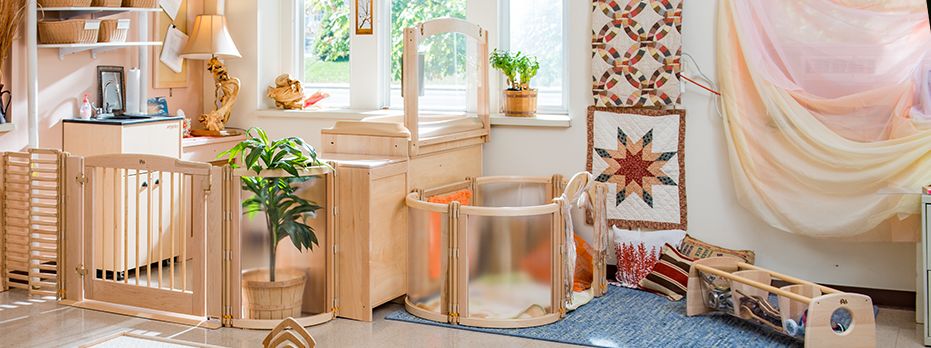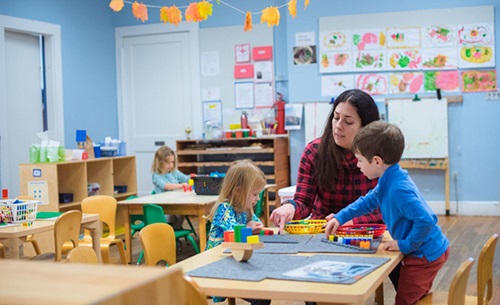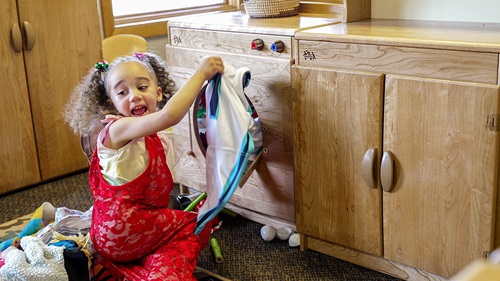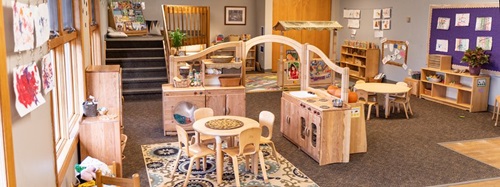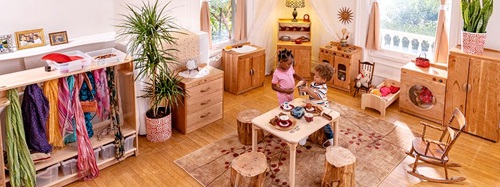Organizing, Editing, and Inspiring
Thoughts on Infant and Toddler Classroom Design In Relation to Brain Development
|
January 2010
Recent brain research makes it clear that many critical aspects of brain development happen during a child’s first few years of life. New connections in the brain are formed quickly when children are very young. In particular, by age three, a child’s brain has about twice as many synapses as a typical adult’s brain. The quantity and organization of connections in the brain, established by experiences during the first ten years of life, influence everything from letter recognition to the ability to manage complex social relationships. The lifelong effects of early brain development underscore how important it is for early childhood centers to be organized to support healthy brain development to the greatest extent possible. In this article we will look specifically at ideas for designing the infant and toddler classroom environment in relation to an understanding of brain development.
The foundation of optimal, healthy brain development is the child’s ability to form secure attachments to adult caregivers. When a child feels safe and secure and knows that her needs will be met and that she can influence the adults in her life to respond to her, she can focus her attention on exploring the world around her. With a “secure base” such as a responsive parent or teacher, a child’s brain can take in all the wonders of the world. This concept of providing the young child with a “secure base” is useful for thinking about the classroom space and the things in it. The idea of the child also needing stimulation beyond the “base needs,” once base needs are met, is also important.
An early childhood classroom is made up of multiple smaller activity areas. Considering the organization of the areas individually, how they are defined or contained, and how they fit together to form the landscape of the classroom can be considered in relation to the “secure base” concept. The design of the classroom should communicate with and support the child in getting her needs met as well as going beyond basic needs to play and explore materials and her body.
Supporting multi-sensory learning should also be a key consideration in the design and setup of the classroom environment. Experiences have meaning and can affect the child through the senses in a much less “filtered” way than adults. Responsiveness to sights, smells, tactile sensations, sounds, and tastes is more intense for very young children because environmentally sensations are new and less is “known.”
The areas that meet the routine needs of the day should be simple, consistent, and child-centered. From a very young age, focusing on building the child’s sense of belonging and the child’s ability to develop competencies is essential. Cubby areas should be functionally arranged near the entry to the classroom, in a space of their own if at all possible. Low walls or freestanding cubby units can form small spaces within the room that are big enough for a few children and parents to take off coats and boots without haste. For infants, the cubby area or entry should be comfortable for the parent. Providing a place for a parent to sit and put down bags while the child gets oriented, respects the importance of leave-taking and reunion time. Think about providing space to say hello and goodbye, have a few last hugs, and talk with the caregiver about the day. Photos or symbolic items on the child’s cubby can identify the child and her family, making it clear that this is her place, where she goes with her parent or teacher. As she grows, she proudly and independently keeps her own belongings here. Heights of hooks and shelves for older toddlers should be placed at their level where they can reach them and store their own things.
Diapering and toileting areas are ideally located with direct visual access to the classroom, so the child knows where they are in the space and so that the teacher can continue to watch what’s happening in the room while she’s occupied with changing diapers. As infants and toddlers get more mobile and more aware of their bodily functions, they can communicate with their caregivers and play a more active role in caring for their bodies. Imagining the environment from the child’s experience should inform planners about lighting (making sure it’s not glaring in the child’s eye, in the ceiling above the changing table) and surfaces that are within reach of the child (they should be safe, cleanable and touchable). While the child should be engaged in eye contact and conversation with the caregiver when being changed, visual stimulation like a mirror on the ceiling or a mobile on the wall can offer opportunities for dialogue and engagement.
The need for providing clear sleep cues is probably well understood by most early education teachers since evidence of the child’s ability to sleep and settle down is observable. Thinking about sensory stimulation from the brain development point of view perhaps just emphasizes the value of reducing stimuli for rest times. In infant rooms dedicated for sleeping, soft light, gentle colors, and the need for separation from play time is clear. For infants, the challenge is assessing when the child is tired and should be placed in her crib for rest.
Typically, six- to nine-month-olds need two naps a day, and two-year-olds need afternoon naps (averaging a total of 12-13 hours of sleep per day). The number of hours of required sleep per day is determined in relation to the growth of the brain. The brain needs time to rest and process stimuli during sleep for healthy growth. Over stimulating children threatens their brain growth. Children who are exposed to curricula without sensitivity to overstimulation are more likely to emotionally withdraw and lose interest in learning.
Since most toddlers sleep in spaces used for other functions throughout their child care day, the biggest challenge is reducing the stimulation of being surrounded by all their classroom equipment. Room darkening can help and the teacher can provide other sleep/relaxation cues like playing quiet music. If teachers talk quietly to children about how good it feels to rest, rub children’s backs and spend rest time relaxing themselves, children will be more able to sleep peacefully.
There are many opportunities during snack and meal times to build routines that engage the child in communicating her needs and being an active part of cooking, serving, enjoying the meal, and clean-up. Thinking about these opportunities in terms of all the senses brings to mind several important suggestions about the classroom design and arrangement.
Classrooms with younger infants need soft, comfortable places where their teachers can snuggle with babies and give them their bottles. A soothing area with a comfortable glider chair, away from noisier distractions of other activity in the room is also a place where a teacher can relax and enjoy one-on-one company with an infant. A cushioned chair in a corner with a small table and lamp (with an incandescent light bulb) is a cozy place to be at ease and focus on being together.
As the infant grows older (six months) and moves on to solid foods, eating can be celebrated as a social experience. All the smells, tastes and tactile sensations of food stimulate conversation and non-verbal communication. Toddlers really work at friendships, so social furniture selection and arrangement is important. Furniture that seats infants at a common table can be considered over high chairs. While high chairs are designed so that adults can stand while feeding, and it is important that the adult caretakers be comfortable, seating children around a table is great for practicing social skills. A seat for the adult may help her to sit and be with the children, instead of multi-tasking on her feet. Chairs that are attached to the table top to hold the child safely in place give the teacher more control. “Me-do-it” chairs that keep older infants and toddlers stable, but that can be moved around by the child, give the child more choice, contributing to her independence, mastery and self-esteem.
In any case, offering fresh food that smells good, is attractive and recognizable, makes everybody feel enthusiastic about breakfast, lunch or snack time! Family-style food service also helps toddlers learn to independently make choices, serve themselves, not take too much food, and try new foods. Cabinets for storing dishes right in the room sends a direct message to children that chores are part of daily life. As Montessori education recognizes and emphasizes, even very young children can be proud of any small role they can play in helping to set or clear the table. And skills like that are really appreciated at home.
It’s also important for toddlers to develop relationships with the folks in the kitchen. Visiting the kitchen and meeting the cooks contributes to a child’s receptive stored information and language development. Toddlers who have a rich experience like visiting a kitchen where large quantities of food is cooked will be more likely to remember where food comes from, and they will value the work of the people who fix the meals.
Keeping a classroom orderly and organized is important for maintaining children’s interest and providing just the right amount of stimulation. To avoid overstimulation, teachers should learn to “edit” and place items that not currently being used in storage. Adequate and organized storage rooms make “editing” a much easier practice. Teachers can experiment with offering fewer materials in a more thoughtful way to present opportunities for more purposeful play. Children will need less adult intervention if materials are edited prior to commencement of play.
Natural light is the fundamental tool for defining spaces, and it provides a sense of wellbeing for adults and children in a room. Think about window placement in terms of how the light will enter the room, views to the outside that will become a part of the room, and as a tool for providing a strong setting on the inside for areas of different kinds of activities. Are there places in the classroom where a child can safely look out a window to watch the rain or the sun shining?
Changes in floor materials provide an opportunity to define work areas and should also be placed mindfully. Area rugs can define floor areas. If low shelving is available to form two to three sides of the work area, consider also how the edge can be defined above the level of the low shelf, through hanging artwork, plants or other transparent screen.
Beyond fulfilling a young child’s basic needs, a classroom offers opportunities for encouraging playfulness, mystery, wonder, and awe. Adults and children enjoy getting up high and looking down on the whole room, crawling inside a small space, hiding, and peeking out of tiny places. Creating a classroom that honors a child’s aesthetic sensibility requires pondering a room’s overall feeling. When creating an environment, step back and look at the space. If it is jumbled, chaotic, unwelcoming and overwhelming for the teacher or parent, it most certainly affects the quality of the learning experience, and the brain development of the child. Planning and creating an adult-child space for imagining, for inserting oneself, for daydreaming, for processing complexities is essential to healthy living and thinking. Just like food or sleep or rest, it is fundamental to development.
Comments
Hello, we just love the articles you send through this publication. We do wonderful things with babies and toddlers, but it is always a “boost” to read the perspectives of others! My favorite line in this article is the one that addresses having “less” things out, with more thought! Exploring the Pennsylvania Standards, and intentionally planning within our center gives way to many ideas (planned around scarves, for e.g).
Keep them coming! Best wishes for all of your endeavors in 2010,
Terry Jaecks

